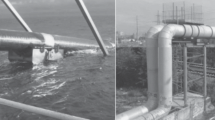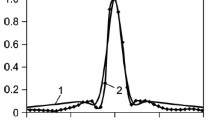The variation in the cross-section of a flow of transported petroleum caused by deformation of a pipeline is estimated. The error of an ultrasonic flowmeter counter for the case in which the current flow cross-section is taken into account is calculated.
Similar content being viewed by others
Avoid common mistakes on your manuscript.
In many cases, ultrasonic flowmeter counters are used to measure the flow of petroleum. The process of establishing the conversion factor of these devices entails taking account of the cross-section of the flow of transported petroleum as determined by the internal diameter D of the pipeline [1], i.e., it is assumed that the form of the cross-section at the site where the ultrasonic flowmeter counter is located is a circle of radius R = D/2. The basic list of the errors that thereby arise is presented in [2]. The actual form of the cross-section differs from a circle, and what is more important, is not a constant quantity, but instead depends on external influencing factors, basically mechanical and thermal stresses in the transportation system. This circumstance results in a marked variation in the resulting error of an ultrasonic flowmeter counter and this factor must be taken into account if the admissible error of the device is much less than ±1%. Below we will consider an approach to estimation and exclusion of the action of external influencing factors that govern deformation of the cross-section of a flow of petroleum and the variation of its area. The technical part of the solution of the problem is proposed in [3] and involves placing m pairs of electroacoustic transducers around the perimeter of the cross-section, each of which supports measurement of the flow rate of the petroleum and the cross-sectional diameter L j , j ∈[1, m]. These data, if properly processed, generate the result of a measurement of the volume (mass) of the transported petroleum.
Let us find the cross-sectional area of a deformed pipeline. Let ƒ(θ) be a function that describes in terms of polar coordinates the current length of the radius of an actual flow cross-section of petroleum. We will consider the case of small deformations of the cross-section that are not noticeable by the service personnel under ordinary conditions. In order to take these deformations into account, we need only represent ƒ(θ) by a cubic polynomial:
where R 0 and x i are the free and variable terms of the polynomial; θ∈[0, ψ]; ψ, upper angular limit of the perimeter of the cross-section caused by its deformation.
It is necessary to determine the constants of this equation based on the continuity condition of the function ƒ(θ) with θ∈[0, 2π]; ƒ(θ)|θ=0 = ƒ(θ)|θ=2π. Then in light of (1) we may write
We will calculate the area of a deformed cross-section, assuming that the perimeters of the deformed and undeformed cross-sections are equal:
where ψ1 is the upper angular limit of the perimeter of the undeformed cross-section.
For ψ1 = 2π, in order to determine ψ in the case of small cross-sectional deformations, we set R 0 = R and in accordance with (1) represent (3) in the form
where a = x 3/4; b = x 2/3; c = x 1/2; d = R; e = −2πR.
Measurements performed with the use of an electroacoustic transducer enable us to obtain quantitative values of the diameter L j , while θ j specifies the site of the jth pair of electroacoustic transducers, j ∈ [1, m]. To determine x i , i = 1, 2, 3, in view of (2) it is sufficient to have two pairs of electroacoustic transducers (m = 2). With j = 1, 2, the values L 1 = ƒ(θ1)+ +ƒ(θ1 + π), L 2 = ƒ(θ2) + ƒ(θ2 + π), respectively, are measured. In the course of operation of an ultrasonic flowmeter counter if θ1 = π/4 and θ2 = 3π/4 can be assured, then, by (1), we have
We set d 1 = L 1 – 2R and d 2 = L 2 – 2R, where d 1 and d 2 serve as quantitative estimates of the deformation of the cross-section.
A solution of system of equations (2), (5) yields
Recalling (6), an exact solution (4) leads to cumbersome formulas. An approximation of the numerical solution of this equation, for example, by an iterative method with maximal computation error not greater than ±1·10−8ψis less complicated. Such an approximation, created by the method of least squares [4], has the form
Here u = (d 1 + d 2)/(2R); a = −0.484844449, b = −0.001274, c = 0.235025 with root-mean-square error not greater than 7·10−6ψ if |d 1|/(2R), |d 2|/(2R) ≤ 0.014, −0.028 ≤ u ≤ 0.
By (3), the radius of the virtual circle equivalent to the deformed cross-section is expressed by the formula R e = = Rψ1/ψ= R2π/ψ, whence the cross-sectional; area
Let us estimate the error of the ultrasonic flowmeter counter caused by mechanical (or thermal) deformation of the pipeline cross-section. Here the variation in the cross-sectional area of the petroleum flow
The results of calculations performed with (9) using (7) are presented in Fig. 1 a. Small deformations in the working cross-section of the flow of liquid |d 1|/(2R) ≈ 1.0% substantially worsen the precision of the ultrasonic flowmeter counter if the actual petroleum flow cross-section is not taken into account. That is, the variation Δ S in the interval between discrete corrections of the information-measurement system containing the ultrasonic flowmeter counter may reach ±2.0%.The technology followed in operational maintenance of the metrological characteristics of the information-measurement system used in measurement of the quantity of petroleum comprises periodic (generally, annually) checking of the system and inspection of these characteristics of the service operation once every 7–30 days. A correction to the readings of the information-measurement system on the basis of a redetermination of the Reynolds number is performed in the interval between inspection operations. However, the actual petroleum flow cross-section is not inspected, though from our studies it appears that the parameters of the cross section may vary over the following ranges as a consequence of variations in the excess pressure in the pipeline and the temperature of the transported petroleum: d 1/(2R) from −0.01 to −0.0125 and d 2/(2R) from −0.006 to +0.0062. In the present case, this induces a variation in the area Δ S from −0.64 to −1.83%.
We may estimate the computation error in S caused solely by the imprecisions in the calculated value of d 1 and d 2 (respectively, δd 1 and δd 2) under conditions introduced in (7) thus:
An increase in the precision with which the petroleum flow rate is measured is achieved as a result of the fact that the current value of the petroleum flow cross-section is calculated from (8) in the computational device that is part of the information-measurement system, and the fact that the conversion factor of the ultrasonic flowmeter counter is calculated from the latter current value [3]. Other external influencing factors are taken into account in accordance with [5]. In determining the resulting measurement error we set δd 1 = 0.01d 1max and δd 2 = 0.01d 2max, with d 2max/(2R) = d 1max/(2R) = 0.014.
The results obtained in the calculation of δ are presented in Fig. 1 b, whence follow the conclusions: ΔS/δ may exceed 50, and the error in the measurement of the petroleum flow rate caused by deformation of the pipeline will not exceed 0.03%.
References
MI 2983–2006, GSI. UFM 500 Ultrasonic Liquid Flowmeter Counters. Inspection Techniques.
G. I. Birger and N. I. Brazhnikov, Ultrasonic Flowmeters [in Russian], Metallurgiya, Moscow (1964).
K. L. Kulikovskii and I. Yu. Yeremin, Patent 2352905 RF, “Meter for measurement of the weight of liquid transported through a pipeline,” Izobret.. Polezn. Modeli, No. 11 (2009).
I. N. Bronshtein and K. A. Semendyaev, Handbook on Mathematics [in Russian], Nauka, Moscow (1980).
GOST R 8.595–2004, GSI. Weight of Petroleum and Petroleum Products. General Requirements on Techniques of Conducting Measurements.
Author information
Authors and Affiliations
Corresponding author
Additional information
Translated from Izmeritel’naya Tekhnika, No. 1, pp. 43–44, January, 2013.
Rights and permissions
About this article
Cite this article
Zorin, Y.V., Eremin, I.Y. Increasing the Precision in Measurement of the Flow of Petroleum in the Case of Deformation of a Pipeline. Meas Tech 56, 61–64 (2013). https://doi.org/10.1007/s11018-013-0159-4
Received:
Published:
Issue Date:
DOI: https://doi.org/10.1007/s11018-013-0159-4





